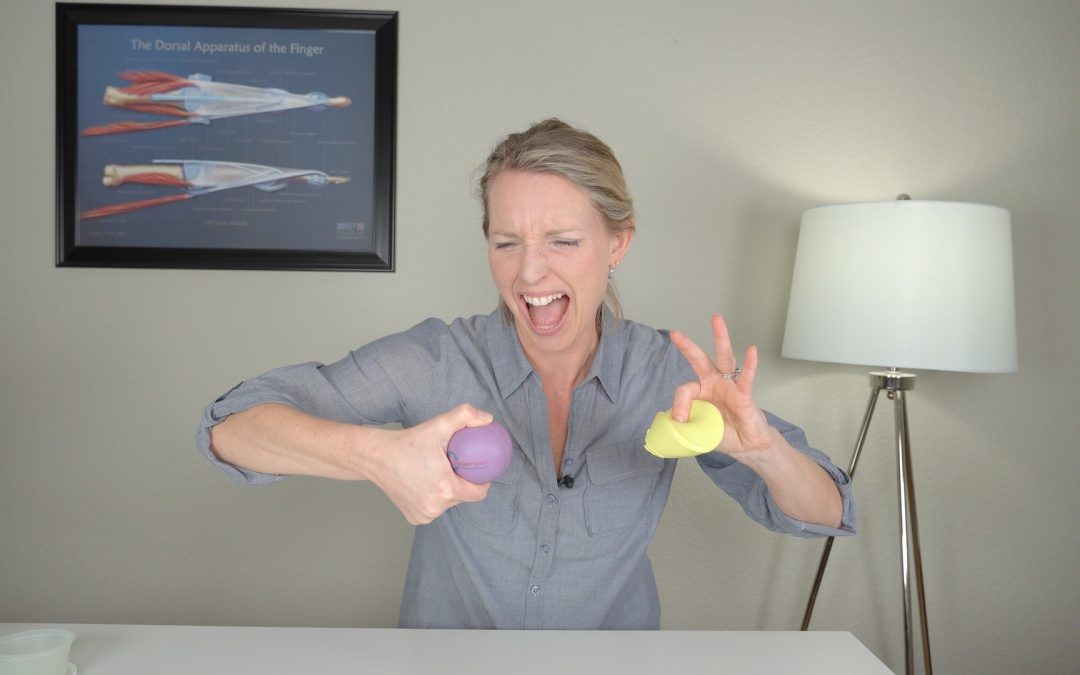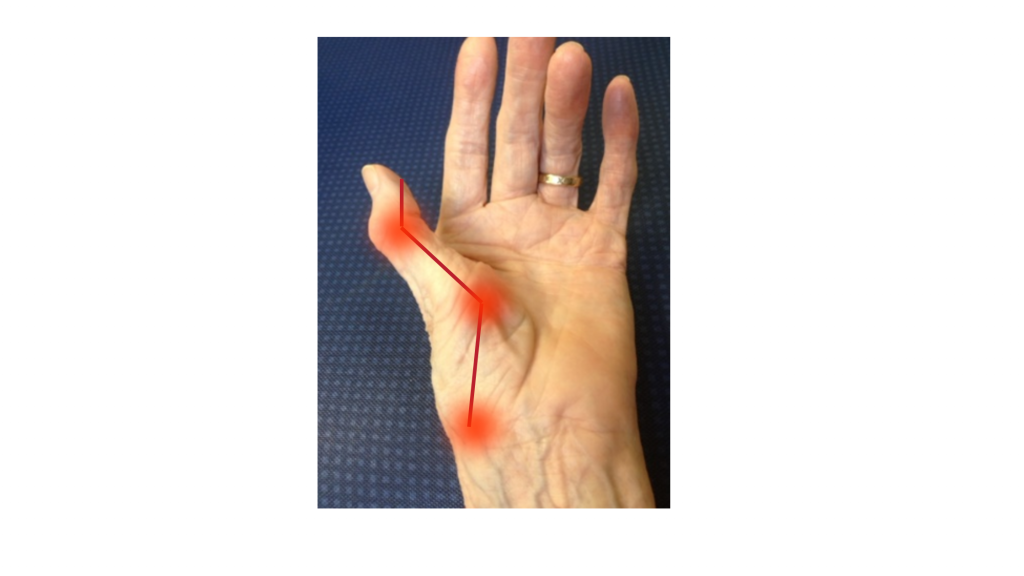Do you want to know what the worst exercise for thumb arthritis is?
I’m referring to thumb CMC arthritis, also known as basilar thumb arthritis. Basically arthritis located at the base of your thumb.
Well… the worst exercise for thumb arthritis is Pinching!
This includes pinching or squeezing a stress ball, putty, or some other gadget you found online that promotes pinching to be the magic exercise that heals your thumb arthritis.
In this blog post, I’ll share the inside scoop why pinching is one of the worst exercises for your thumb arthritis. But more importantly, I’ll share a more effective exercise to do instead.
If you prefer video, you can watch the worst exercise for thumb arthritis from my YouTube channel here:
Let’s get right to it!
Reason #1: Pinching can increase pain and your thumb arthritis
Pinching involves repetitive and forceful movements of all your thumb joints. Arthritis is known as the wear and tear of the cartilage between the metacarpal bone of your thumb, and the trapezium bone of your wrist.
Pain with pinching is often one of the 1st symptoms you have with thumb arthritis. In fact, depending on how hard you are pinching and the resistance of the object, you could be loading the base of your thumb up to 13xs MORE than the tip of your thumb.
In fact one study showed that just a simple pinch compresses your top thumb joint (aka your IP joint) 3 kilograms which is equal to 6.6lbs. Your MP joint (aka the middle joint of your thumb) compresses 5.4 kilograms which is nearly 12 lbs with the same simple pinch.
But the base of your thumb was loaded at a whopping 12 kilograms, which is equal to 26 ½ pounds!
That’s a lot of force on your small joints.
This pinching can worsen your arthritis symptoms because you are repetitively loading the base of your thumb over and over again. And depending on the stage of your arthritis, you may have little to no protective cartilage to take that force.
Therefore, pinching can lead to increased joint pain, more inflammation, and possibly more arthritis development.
Reason# 2: Pinching encourages a loss of your palmar arch and thumb web space
As your thumb arthritis worsens, you lose that ability to open your palm and thumb out wide. You lose your normal palmar arch space due to the shift that occurs at the base of your thumb.
Just like in reason #1, as your cartilage wears out, this causes more strain to important stabilizing ligaments. Eventually causing a gradual shift of your thumb to occur.
Over time, your thumb starts moving into your palmar space. And with LESS SPACE in your hand to hold things, this causes MORE strain to your thumb.
This starts to affect your ability to hold or pick up objects and therefore decreases your grip and pinch strength.
So, I hate to tell ya but that repetitive pinching isn’t going to improve your palmar arch or thumb webspace.
The pinching will contribute to more loss of range of motion, unless you have learned how to correct this first.
Reason #3: Pinching strengthens the wrong muscles
Don’t get me wrong, pinching can be a great way to strengthen your thumb and fingers. But not if you have thumb arthritis.
How you pinch is important.
The reason why pinching is labeled the worst exercise for thumb arthritis comes down to the position of your thumb when you pinch.
The most typical pinching patterns are with the tip of your thumb flat, or pinching with too much flexion at the tip of your thumb.
This type of pinching over and over again will cause ligament laxity and therefore, joint instability. When this happens, you start recruiting compensatory muscles and tendons to get the job done.
What you are NOT doing is strengthening very specific key stabilizing muscles that actually SUPPORT your arthritic thumb joint.
Plus it completely depends on the type of pinches you are performing.
I bet you didn’t realize there are 3 types of pinches too, each one working your thumb a different way.
Reason #4: Pinching is more of an advanced exercise
When you really think about it, pinching is an advanced thumb movement. It requires you to have a good range of motion of your thumb and fingers.
Pinching requires fine motor control, dexterity, coordination, strength, and stability of multiple thumb and finger muscles in order to apply the precise amount of pressure.
But often there is no training on the appropriate resistance or load. Or HOW to progress the pinch appropriately and safely when you have thumb arthritis.
There are better alternative exercises, and more effective exercises, that do not put stress on your thumb joints. I’ll share one with you shortly.
And finally, reason #5: Pinching focuses more on quantity over quality
Are you really counting or even paying attention when you are pinching a ball or putty?
You are likely doing 100, 200, or 300 pinches, while you’re watching TV or scrolling on your phone.
The problem is these pinches are typically of poor quality because you are not focusing on training the correct stabilizing muscles that surround your thumb joint.
It’s no different than pinching open a bag of chips 200 times. OUCH!
Bottom line is to focus on proper form and technique, rather than resistance or repetition.
What exercises to do instead.
Don’t get me wrong, I am not saying you shouldn’t pinch when you have arthritis. I’m saying using repetitive pinching to try to help your arthritis pain is not the best approach.
Now that I’ve hopefully proved my point about pinching being the worst exercise for thumb arthritis, what should you do instead?
The answer is Isometric Ball Grips.
This is NOT squeezing, gripping, or pinching your thumb repetitively. This is much different and way more effective.
You will need a tennis ball, lacrosse ball, or yoga therapy ball like I have here.
Side note, a yoga therapy ball is slightly smaller in diameter than a tennis ball and is more comfortable for smaller hands.
Why use a ball?
The ball contours and supports your palmar arch and webspace. Making strengthening less painful and more effective.
Also, the ball helps position your CMC joint in a more stable position, which is in a little bit of extension and abduction.
Your MP joint and IP joint are placed in slight flexion. No more straining your ligaments from unsupported pinching.
In fact, one study in the Journal of Hand Therapy supported the benefits of using a firm ball as a part of a dynamic stability program.
To do this exercise, place the ball in the palm of your hand. Make sure it touches your palm completely and there is no gap.
Place your wrist down on a table or your lap with your thumb on top of the ball. The table, or your lap, will support the ball in your palm.
Next, you want to press your thumb into the ball, maintain all 3 thumb joint positions. Hold for 5 seconds, then relax.
This does not need to be a hard squeeze, you start with as much pressure as what feels good for you.
You should feel the muscles at the meaty part of your thumb contracting.
Repeat this exercise 10-20 repetitions daily. Starting with 1 set then working up to 2 or 3 sets.
As you can see this exercise focuses on the quality of the correct muscles over quantity.
You’ll get far more results with 10 of these versus 1000 of the putty squeezes. Plus this isometric ball grip won’t further contribute to your arthritis.
This is not a magic thumb arthritis exercise.
This exercise may not be for you if you have more advanced arthritis or already have a noticeable loss of your palm arch, or can’t curl the ball without there being a gap.
With all that said, some people try everything to no avail and surgery is necessary.
Thumb replacement surgery can be a very life changing option. However, it comes with surgery expenses, healing time, post operative pain, incision care, scarring and swelling, etc.
Just make sure you pick the path of treatment that works best for you.
New Thumb Arthritis Training Program Can Help
Now, if you liked that exercise and want to try options other than surgery or injections then consider joining my NEW thumb arthritis training program:
30 Day thumbs is a Turn-key progressive exercise program created to stop thumb arthritis pain, prevent future flare ups, preserve joint health, and boost dynamic stability for optimal thumb use.
Over a course of 4 weeks, I will coach you through a series of stretches and exercises designed to build healthy, sustainable thumbs, while also teaching you lifestyle modifications to achieve long term pain relief.
I have made it easy for you by laying out the EXACT stretches and stability exercises to perform each and everyday. Taking you only 5-10 minutes total to complete.
At the beginning of each week, I will also host a LIVE video demonstration of the exercises to make sure you are doing them correctly AND effectively.
And as a bonus, you will also receive my Thumbs Up Tool Kit- full of resources, guides, and educational tips to help you navigate all THUMB related products such as gloves, braces, gadgets, hot packs, and more.
Not to mention, you can complete the program anywhere and minimal equipment is required.
BUT since no 2 thumbs are alike, and you can’t undo years of wear and tear, this program can be adapted to suit you, whether you need to take a little more time or want to make it a little less intense.
Click on the link here to see what others have to say.















